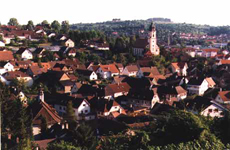

Altdorf Torah
 |
Altdorf Home  |
Background |
Synagogue | Pictures |
Related Links | Ortssippenbücher | ||
| The Altdorf Torah |
Maps | Databases | Books |
| Although Jews are first
mentioned in the 1570s, they first settled there in 1716
after expulsion from nearby Ettenheim. Although
Altdorf was more tolerant of the Jews than many other
areas of Baden, few Jews lived there in the early 18th
century; by 1752 only 16 Jewish families were recorded in
tax records. The number increased significantly
after the Edict of Toleration in 1781; Jews were allowed
to deal with non-Jews, to learn many trades, establish
their own schools and attend a University. However
Jewish poverty did not abate and Jewish peddlers roamed
the countryside. Since they were forbidden to deal
directly with Christians, many sought refuge among the
Jews in Altdorf, leading to further increases in
population. Jews attained a population of 313 in 1855. Altdorf held special attraction to the Jews. In this small rural community, they could make a living as traders, especially in livestock or artisans. Altdorf's religious profile was somewhat unique among other Baden villages. It did not convert to Lutheranism and remained predominantly Catholic with only a few Protestants. The Jewish population was significant in the 19th century. From 1813 to at least 1871 it ranged from 20 to 21 % of the total population. The 20th century was a different story. By 1933 (Hitler's appointment as Chancellor of Germany) the Jewish population had declined to just 51. Between 1937-1939 many of these emigrated or moved to other German communities. On Kristallnacht (9-10 November 1938) the synagogue and Jewish homes were vandalized. Eight Jewish men were detained in the Dachau concentration camp. On October 22, 1940 the last 12 were deported to the Gurs concentration camp, eight perishing in the Holocaust. Another 15 of the Jews also died who previously left the town. The arch in
Altdorf is all that remains of the home of Leopold and
Leoni Dreifuss of Altdorf. Leopold had been the
Kosher butcher for the community. Until the
Nazi's deported the couple and burned down their home,
the arch was the doorway to their home. The
Kippenheim synagogue was built in 1850-1851 and served as a
local congregation until its desecration in November
1938. From 1986 to 1989 its beautiful exterior was
restored to original condition and its former interior
is being preserved. Other synagogues were destroyed or
remain as altered structures, including one in
Altdorf. The Jewish cemetery in Schmieheim was
established in the 17th century and many stones remain
legible, still recounting Jewish heritage and family
lineage. Extensive remedial work has restored
the cemetery and the beautiful grounds are well
maintained to this day. However, the beautifully
colored sandstone headstones are beginning to
deteriorate from time and perhaps the pressure of
rubbings from visitors to the site.
The above information was
obtained largely from two
primarily sources of information. "The Encyclopedia of
Jewish Life Before and During the Holocaust,” New York
University Press, Copyright 2001 by Yad Vashem
Jerusalum, Israel, and "Determinants of Change and
Response Among Jews and Catholics in a Nineteenth
Century German Village", by Alice Dreifuss Goldstein,
Jewish Social Studies Mongraph Number 3, New York
1984. |